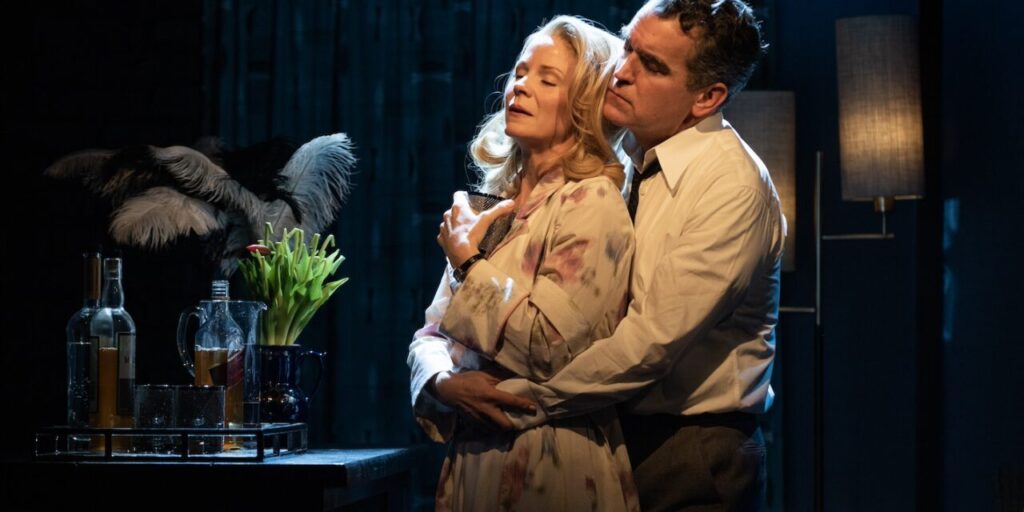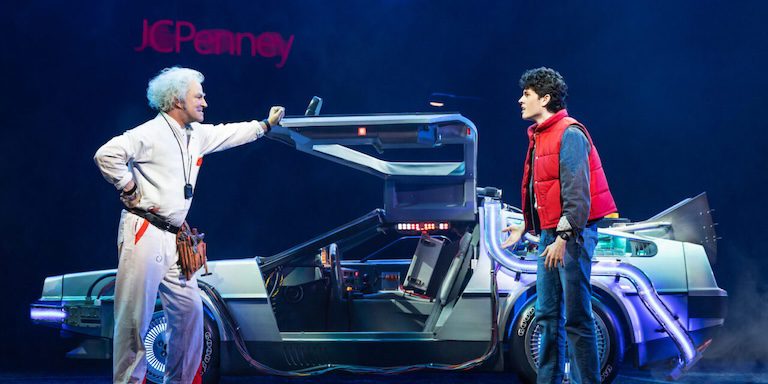By Barbara & Scott Siegel . . .
IN ORDER TO SURVIVE, BROADWAY GOES BACK TO THE FUTURE!
Back to the Future: The Musical has been playing to packed houses for months, with no signs of letting up — including during the bleak months of January and February. Other than the sensational special effects, there is nothing ground-breaking about the show. To be sure, the music and lyrics by Alan Silvestri and Glen Ballard are serviceable and even occasionally top notch (”For The Dreamers” might have a future outside of the show), the book by Bob Gales, who wrote the original screenplay with the film’s director Robert Zemeckis, is understandably (and smartly) very true to the original movie.
The musical isn’t playing politics, it isn’t injecting racial issues, it isn’t woke; it isn’t right wing, it isn’t anything but an old-fashioned show playing its ace card: nostalgia for a much-beloved and famous film. This adaptation for the musical theater stage has only one purpose in mind: to entertain! And the surprising thing is how relatively rare that has been on Broadway since shows opened back up after the pandemic.
Producers and subscription theater companies were falling all over themselves to put on new plays and musicals to appeal to audiences that actually did not exist. No wonder they failed. Of course, most shows fail even in the best of times, but it seemed like there was a headlong rush into productions that would have been lucky to get limited Off-Broadway runs that were pumped up to Broadway size and rapidly crashed and burned. But the pendulum seems to be swinging back toward putting on shows that audiences might actually want to see.
Mind you, we’re not just talking about shows that are all fluff and no substance. There is a place for that — a rather large place, if you want to eat — but Broadway has also been a home for important, meaningful, and provocative work that can, and do, bring in audiences. And those shows do so because they are written with specific, theater-going audiences in mind. And those kinds of plays are making a comeback now, as well, after a couple of seasons of shows that seemed as if they were written for ten of your closest friends, shows that were depending upon well-meaning critics to send people to shows that there was no way they were going to like. But things are changing…

A perfect example of this is Prayer for the French Republic by Joshua Harmon at the Manhattan Theater Club has put up at its Broadway house, The Samuel J. Friedman Theatre. Of course, the play has the advantage of a subscription audience, but this is a show that has a natural affinity with Manhattan Theater Club’s older and more sophisticated subscribers. Besides being a great piece of work (that always helps), it appeals to the same substantial audience that made Leopoldstadt a hit: the Jewish audience and those looking for intelligent, challenging theater.


Of course, it doesn’t always work. Days of Wine and Roses (book by Craig Lucas and music and lyrics by Adam Guettel) is a dark and serious musical, moving to Broadway after a hit Off-Broadway run. You couldn’t find a better cast led by Brian D’Arcy James and Kelli O’Hara. but it’s appeal would appear to be limited to its stars and its composer, not so much the actual piece. Once the insider theater audience who cares about such things has seen the show, the audiences are otherwise not coming.
Days of Wine and Roses is not a “Broadway musical” in the manner of the traditional fare that tourists buy tickets for when they come into town to see a Broadway show. It’s an art song musical. Some of it is stunning. The acting is brilliant. But it’s not a commercial piece of work. It is, however, properly in a subscription theater (The Roundabout’s Studio 54) with a limited run. Bless them for trying.
Right now, more than one-quarter of Broadway’s theaters are dark, awaiting the tsunami of shows that are coming in the next two months to beat the Tony deadline. As always, there is going to be carnage when shows suddenly come up against either deadly reviews or audience resistance. Or just bad luck. Our guess is, however, that the ones that succeed in this tight and tenuous market will be those that go back to verities that brought them success in the past. In other words, they need to go back to the future.
Featured Image: Roger Bart and Casey Likes (Back to the Future)


















